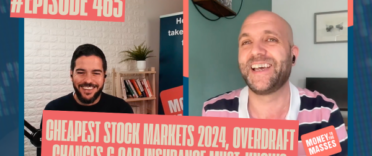The 113th episode of my weekly YouTube show where I discuss what is happening in investment markets and what to look out for. This week I explain how fear is slowly creeping in and what that could mean for markets.
Each show lasts between 5-10 minutes and is aimed at DIY investors (including novices) seeking contemporary analysis to help them understand how investment markets work.
Subscribe to my YouTube channel to receive my weekly analysis of investment markets or alternatively, you can listen via my weekly Midweek Markets podcast below.
Midweek Markets weekly podcast
Other ways to watch, listen and subscribe
You can listen to other episodes and subscribe to the show by searching 'Money to the Masses' on Spotify or by using the following links:
Abridged transcript - Midweek Markets episode 113
Hello and welcome to the latest episode of Damien's Midweek Markets, the show where I talk about what's been going on in investment markets and what to look out for, in the days and weeks ahead,
Rotation
Where has the first half of this year gone? Regardless, it's a pretty good time to reflect upon what's been going on in investment markets. Now, if you look at the trends that we've seen in markets since the beginning of the year, one of the words that would stand out and probably best describes what we've seen is the word “rotation”
At the end of February bond yields burst higher, particularly on the 10 year US treasury, as investors start to jump out of bonds fearful of a spike in inflation. Then we saw the “reflation trade” really kick in, which meant that value stocks started to outperform growth stocks (i.e things like financials and cyclicals performed much better than the likes of technology stocks).
By mid-May, growth stocks globally were down -2.5% (as measured by the MSCI ACWI Growth index) versus a +10% for value stocks (as measured by the MSCI ACWI Value index). A significant difference. But since that point, the market narrative has once again changed.
The US Federal Reserve, in particular, began to promote a narrative that inflation was transitory in the US otherwise it would act to quash it. Other central banks around the world also promoted the same narrative in relation to their own respective economies.
As a result, the reflation trade has since stuttered and begun unwinding to a certain extent. Growth stocks are up globally by approximately 11% since mid-May, which is a huge rebound and an almost parabolic move higher. Conversely, the MSCI ACWI Value index is up only 3.2% since mid-May, which in isolation is still good but the index lags its growth counterpart.
Overall, year to date, MSCI ACWI Value index is still leading the MSCI ACWI Growth index, by 12.81% versus 9.44%.
Of course, the recent turnaround for growth stocks and the market in general does pose one potential problem - that the market has doubled down on the idea that inflation is going to be transitory. If inflation turns out to not be transitory then we could see another rapid repricing of assets that includes equities and bonds i.e the reverse of what we've seen in the last few weeks.
Year to date equity market performance
If we look at some of the year to date performance figures for the major equity market indices then interestingly, European equity markets have kept pace with their US counterparts as shown in the table below. Don't forget that European indices tend to have exposure to sectors such as energy stocks or some of the cyclical stocks that performed badly poorly during the lockdown of 2020, but rebounded once a COVID-19 vaccine was discovered.
| Index | % year to date performance in local currency |
| Deutsche Borse DAX 30 Performance | 14.37 |
| S&P 500 | 14.26 |
| FTSE Eurofirst 300 | 13.83 |
| Nasdaq 100 | 13.07 |
| MSCI ACWI | 12.61 |
| Dow Jones Composite Average | 12.49 |
| FTSE 100 | 8.93 |
| MSCI Emerging Markets | 7.04 |
| MSCI AC Asia ex Japan | 6.52 |
| Nikkei 225 | 4.91 |
So you can see there's been a broad rally in equity markets so far in 2021. And of course, yes, there's been sector and style rotations back and forth. But if we look at the big picture, equity markets have been pushing higher for more than a year (since the pandemic low on 23rd March 2020) and in many cases are hitting new all-time highs (particularly in the US and Germany). The rally has broadened out over the last year to include both value and growth stocks and most equity sectors and geographies.
Also, if you look at the VIX (often called the market fear gauge) it has dropped from 27 to 16.79 so far this year (well below its long-term average). It shows that fear has been evaporating in equity markets, albeit interspersed with brief periods of heightened volatility and anxiety.
We've also seen the 10 year US treasury yield rally from 0.9% to 1.45%. That is, again another indicator that people are quite happy taking on more investment risk by moving out of bonds.
It's all thanks to central banks boosting liquidity via quantitative easing (QE) and ultra-low interest rates in the wake of the pandemic.
Investors are fearful
We’ve recently entered the second year of this bull market run with many people now thinking that markets have become too frothy and investors too greedy so a pullback is inevitable. But if you look at the CNN Fear and Greed index which takes into account a whole host of indicators to try and determine the underlying emotion driving markets, fear is in the driving seat at the moment. And that's because we've started to see stocks slightly underperform bonds in recent weeks, but also because stock market breadth has been starting to weaken in a number of equity indices. Breadth is where we look at the number of stocks that are making new highs vs new lows. At the moment there are signs that more and more stocks are starting to make new lows, which is something to keep an eye on. If breadth keeps falling then ultimately so will equity markets. We are not quite there yet.
But history suggests that we are likely to see some kind of equity market pullback in this second year of the bull market, regardless of investor emotion. I will cover this in more detail for 80-20 Investor members in the monthly newsletter which they will receive on Saturday.



